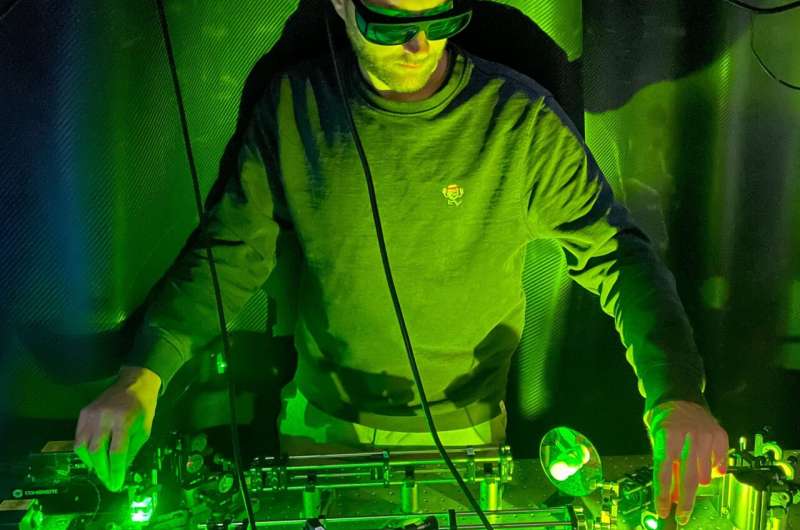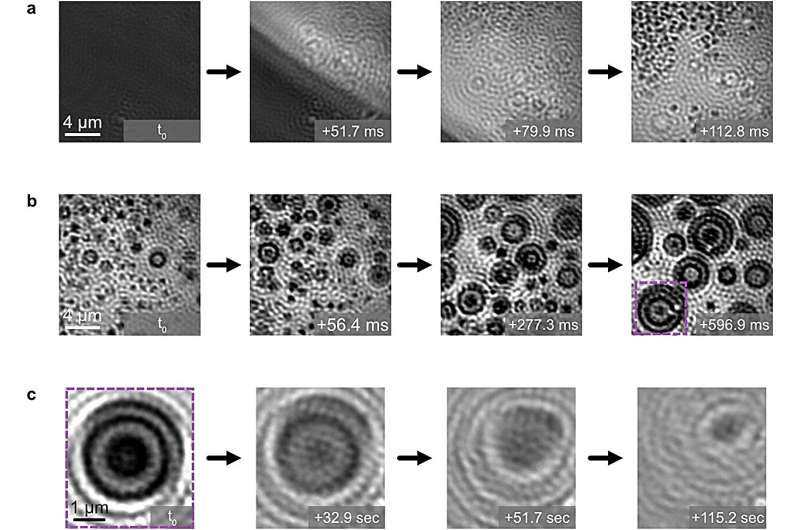This article has been reviewed according to Science X's editorial process and policies. Editors have highlighted the following attributes while ensuring the content's credibility:
fact-checked
peer-reviewed publication
trusted source
proofread
Researchers film energy materials as they form

Shooting a movie in the lab requires special equipment. Especially when the actors are molecules—invisible to the naked eye—reacting with each other.
"Imagine trying to film tiny lava flows during a volcanic eruption. Your smartphone camera wouldn't be up to the job. First, you'd need to develop a special method to make the action you want to capture visible," says Prof. Emiliano Cortés, Professor of Experimental Physics and Energy Conversion at LMU.
But the effort is worth it—particularly when the product of the reaction is a promising energy material: so-called covalent organic frameworks (COFs). Still quite young, this material class has great potential for applications in battery technology and the manufacture of hydrogen.
But despite 20 years of intensive research, scientists have been unable to fully elucidate what actually happens during the synthesis of COFs. As such, materials are often developed by trial and error. This has also been the case for COFs where several molecular components have to find the correct place during synthesis. Only then does the desired porous framework form over large areas.
"Finding out why synthesis only works under certain conditions and not under others has intrigued me since my master's days. Our approach in this project was to use the tools of physics to support chemists in their work. We wanted to shed more light on the complex synthesis processes and thus optimize them," explains Christoph Gruber, who is researching this topic in Cortés's team as part of his doctoral dissertation. To this end, the two scientists turned to the research group of LMU chemist Prof. Dana Medina, who is specialized in the synthesis of COFs, to establish a collaboration.
For the film shoot with the molecular stars, Gruber used a special microscope. With this tool, the team managed to follow the formation mechanism of the COFs at the nano level. The LMU researchers recently published their groundbreaking results in the journal Nature, accompanied by a video showing the processes that occur during synthesis in real time.
Early order is critical
Synthesis of the molecular frameworks demands one thing above all: precise control of the reaction and self-assembly of the molecular building blocks present. "Only when you have this control is it probable to obtain a highly crystalline structure with an extensive order and, ultimately, the desired functionality," says Medina.
"However, our knowledge, particularly of the early stages of nucleation and growth, is full of gaps. And this has thwarted the development of effective synthesis protocols. We therefore were extremely intrigued to visualize the reaction as it unfolds and set the focus on the earliest stages when the mixed molecular components are starting to react."
This is precisely where Gruber started with his investigations, choosing what would seem at first glance to be an unconventional method to cast light on the opening scene of COF formation: iSCAT microscopy. The abbreviation stands for interferometric scattering, and biophysicists often use this technology to investigate things like the interaction of proteins.
"The measurement principle is based on the fact that even the tiniest of particles, made up of just a few molecules, scatter incident light. If these scattered light waves overlap, we get interference—just like water waves in a pool. That is to say, we get larger and smaller waves depending on how the waves overlap.
"We record these light patterns with a high-resolution camera and, with subsequent image processing, we obtain pictures that reveal, for example, nano-scale COF particles," explains Gruber.
And here's the kicker: the iSCAT method is suitable for capturing dynamic processes and thus for real-time measurements. This allows the researchers to watch the synthesis live, as it were.
Droplets got talent
Immediately after the reaction started, the researchers were surprised to observe the presence of tiny structures in the transparent reaction medium. "The images showed us that nanometer-scale droplets can play an essential role in the synthesis. Although they are extremely small, they control the entire kinetics at the beginning of the reaction," says Gruber.
"Nothing was known about their existence before now, but for the formation of the COFs we studied, the nano-droplets turned out to be extremely important. If they are absent, the whole reaction happens too quickly and the desired order is lost."
Using the iSCAT method, the LMU team managed to record a film showing the formation of the molecular frameworks from the beginning—with a sensitivity of just a few nanometers. "Existing techniques couldn't capture the start of the reaction, with these nano-scale and millisecond-long processes, in real time," says Cortés.
"Through our research, we've now managed to close this gap in our knowledge. At the same time, we're getting a holistic picture of the early stages of the reaction and the progressive formation of the COFs."

Energy-efficient synthesis
Furthermore, the researchers used the film clip and the resulting analyses to design an energy-efficient synthesis concept.
"Building on our results, we discovered how to rationally design the reaction conditions," explains Medina. "By adding normal table salt, for example, we were able to massively reduce the temperature, such that the molecular frameworks form at room temperature as opposed to 120 degrees Celsius."
The researchers are convinced their results will transform how we think about the synthesis of the over 300 different COFs and could therefore drive forward advances in industrial COF production. Moreover, the results could have far-reaching effects on the synthesis of other materials and on chemical reactions that have not yet been observed in real time. The LMU researchers are excited about shooting new films with molecules in the starring role.
More information: Christoph G. Gruber et al, Early stages of covalent organic framework formation imaged in operando, Nature (2024). DOI: 10.1038/s41586-024-07483-0
Journal information: Nature
Provided by Ludwig Maximilian University of Munich





















